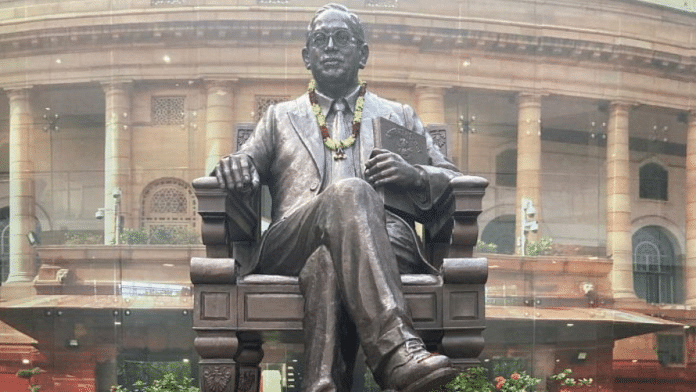Thank you dear subscribers, we are overwhelmed with your response.
Your Turn is a unique section from ThePrint featuring points of view from its subscribers. If you are a subscriber, have a point of view, please send it to us. If not, do subscribe here: https://theprint.in/subscribe/
Babasaheb Dr. B.R. Ambedkar’s lifelong message was “Educate, Organize, and Agitate,” showing that one of his most significant calls to the Dalit community was to prioritize education. However, several times, I am astounded to see some self-proclaimed Ambedkarites and so-called intellectuals spreading a misleading narrative on social media platforms like Facebook, Instagram, X, and WhatsApp. They claimed that Babasaheb was betrayed by the educated class of Dalits. In my view, this claim is not only baseless but also a serious distortion of Babasaheb’s thoughts and legacy.
Most of those who spread such ideas are unemployed individuals who dream of being accepted as leaders by promoting such claims. To do so, they continuously poison the minds of common Dalits against educated Dalits. As a result, the relationship and communication between the Dalit masses and educated Dalits breaks down. In many cases, it seems these individuals have only read a little about Ambedkar and have not understood his statements in the proper context.
One of the popular arguments of these self-declared Ambedkarites is that Babasaheb sent some Dalit youth abroad for higher education in the hope that they would lead the Dalit liberation movement, but they failed to do so. While it is true that Ambedkar may not have been fully satisfied with their contributions, he never said that he was betrayed by them. As I read in Anand Teltumbde’s book Iconoclast, Ambedkar helped these youths obtain scholarships but did not pay their fees out of his own pocket. This clearly indicates that they were free to pursue their future as they wished.
If Ambedkar had truly been disappointed with the educated Dalits, why would he have established the Depressed Classes Education Society in 1928? The goal of this society was to organize school education for the Depressed Classes. With support from the British government, Ambedkar successfully opened five hostels for students of the Depressed Classes in Pen, Thane, Nasik, Pune, and Dharwad.
Ambedkar also launched publications like Mooknayak, Samata, and Bahishkrut Bharat and wrote extensively on social issues. If he felt betrayed by educated Dalits, then for whom was he writing about the critical issues of Hindu society, such as caste discrimination and untouchability? Why did he self-publish his revolutionary work Annihilation of Caste with his own money? For whom was he demanding separate electorates and urging people to enter government services and policy-making institutions?
Even during the peak of the Indian national movement, on July 8, 1945, Ambedkar founded the People’s Education Society to promote higher education among students from marginalized groups. The first institution under this society, Siddharth College of Arts and Science, was established on June 20, 1946, in Mumbai, in old military barracks rented from the central government. Ambedkar successfully secured a grant of three lakh rupees and an interest-free loan of another three lakh rupees from the government to support the initiative.
This move, however, was criticized by Govind Malviya, son of Madan Mohan Malaviya, who argued that such government aid would promote sectarianism. Ambedkar sharply responded that no institution could be more sectarian than the Banaras Hindu Vidyapith, founded by Malviya’s father. Though it was called a Hindu university, in reality, it was a university for Brahmins, with hardly any faculty from non-Brahmin backgrounds. Some departments, he pointed out, were entirely closed to non-Brahmins.
A major setback to Ambedkar’s leadership occurred due to the lack of education among the wider Dalit population. When the All India Scheduled Castes Federation (AISCF), founded by Ambedkar, contested the 1946 Central Legislative Assembly elections, the results were deeply disappointing: the Congress won 123 out of 151 Scheduled Caste seats, while the AISCF secured only two. This electoral defeat raised doubts in the minds of the British about whether Ambedkar truly represented the Dalits. As a result, the British began giving more importance to the Congress’s position on Dalit issues, and Ambedkar was not taken seriously by the Cabinet Mission.
These historical facts make it clear that the claim of betrayal by educated Dalits is not only fabricated but also misleading. If the Dalit community had been more educated at the time, Ambedkar’s party might not have performed so poorly in the 1946 elections. That defeat was a result of widespread illiteracy and lack of social consciousness, not any betrayal by the educated class. Today, the global recognition of Ambedkar’s ideology, literature, and movement is the result of the relentless efforts of educated Dalits.
(Dr. Krishan Kumar is a Political Sociologist and expert on caste issues in Haryana, Assistant Professor of Political Science, Lovely Professional University, Punjab.)
These pieces are being published as they have been received – they have not been edited/fact-checked by ThePrint.



Remarkable